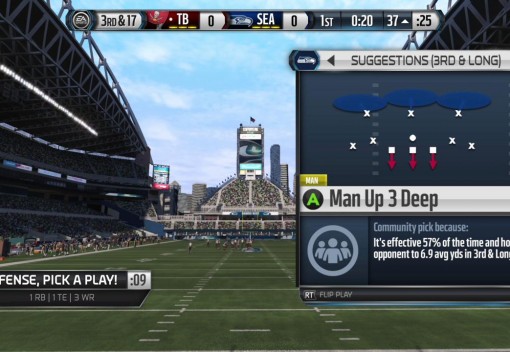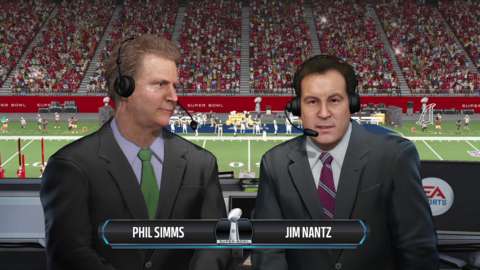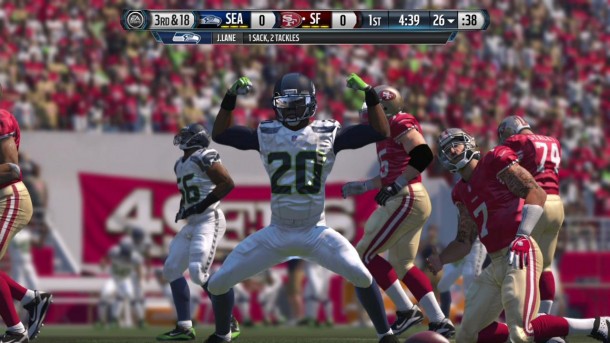Madden NFL 15 Review
Last year's Madden 25 didn't feel like the franchise's true next-generation debut. Inconsistent production values, holes in the passing game, and mechanical stagnation made what many had hoped to be a fresh start seem stuck in the mud. Thankfully, Madden 15 corrects the course by taking two big steps in the right direction. Firstly, revamped defensive play gives you a reason to actively participate as you defend a drive; secondly, precise attention to detail creates a more cohesive aesthetic package. Deficiencies in the passing game along with technical hiccups stemming from the game's often-comical physics still exist, but Madden 15's few missteps do little to detract from an otherwise strong outing.
Controlling the defense has felt like an afterthought in recent years, since your actions as an active defender rarely made an impact on the progression of the play. But Madden 15 focuses on making it fun to play both sides of the ball. The most immediate change you’ll notice is a camera angle positioned behind whichever defender you control. If you’re on the line, you’re asked to time your attack to the center’s snap and fight your way through traffic to take out the quarterback. Favorable matchups allow you to slink past the offense through timely button presses, and once you’ve broken through, you’re given a handy visual indicator to illustrate your tackling range. The safest route is to use the more reserved tackle that almost guarantees an easy sack, but you can also make use of the less accurate hit stick if you’re feeling lucky. This has a greater chance of popping the ball free or even causing a game-changing injury.
If you’re looking to force interceptions, controlling a member of the secondary remains advantageous since you’re more likely to pick off a pass when you’re in the driver’s seat, rather than when trusting the AI. The behind-the-back view that works so well for a pass rusher is disorienting when you swing over to a safety or cornerback, but on-the-fly adjustments allow you to switch to the classic camera angle that’s more advantageous in these circumstances. Still, you’re more equipped to defend passes than ever before as long as long as you stay tight on a receiver, and barreling through a strong offensive line to drag a top quarterback to the ground is supremely satisfying. Systems that previously felt automated now require your undivided attention, giving you more reasons to stay engaged in all four quarters of a game.
When it comes to offensive play, the changes are more often seen than felt. The interface for picking plays has been revamped, cleaning up much of the previous clutter and giving you helpful information about suggested calls. Less-seasoned players who prefer to just settle for suggested plays often had little idea why short passes were more effective when the defense was about to blitz, or how one run play was likely to produce more positive yards over another. The logic behind the choices was hidden, but Madden 15 provides an explanation for the more casual football strategist. Coach’s suggestions are coupled with text that might mention how the opposing team is often vulnerable to a particular play during a specific down, while additional plays often used by the community show success rate and average yards gained. Experienced players will likely choose their own formation and offensive maneuvers, but taking the game’s advice is both viable and edifying.
Favorable matchups allow you to slink past the offense through timely button presses, and once you’ve broken through, you’re given a handy visual indicator to illustrate your tackling range.
The running game made considerable strides last year thanks to the improved interaction between the offensive and defensive lines, and it only feels sharper this time around. Breaking tackles, finding holes, and trucking past defenders looks and feels great, and the different attributes of each player--whether it be their acceleration or physical strength--are felt as soon as the ball is snapped. Pass plays, on the other hand, can lead to some frustrations. You have a great deal of finesse with the ball when taking control of a QB, as you’re able to throw bullet passes, lobs, and lead receivers if the coverage is tight. Receivers even make more creative catches than ever before, as it’s not uncommon to see daring one-handed grabs or long dives for passes just out of reach. But interceptions happen too often, and even the strongest receivers just don’t do enough to battle for the ball. Good defenders frequently prevent great receivers from making plays in single-coverage situations, so battling an adept secondary like Seattle's can feel like a lost cause.
The vanilla Play Now and online Head-to-Head modes are there for the exploring, and they’re the best way to go if you just some want to throw on some pads and take to the field. But Connected Franchise is quickly becoming a feature attraction, and it’s been given a bit of a facelift this year. Here, you choose between becoming a player, owner, or coach of your favorite franchise, which gives you the power to either affect the flow of individual games or get deeply involved in the team’s upkeep. The newest additions are a “Game Prep” feature and a statistic for individual player confidence. Game Prep provides different activities during a given week that give you more experience to sharpen your skills, while confidence takes into account the ups and downs even veterans feel from week to week.

Both add variety to the routine, providing more to do as a created player before the next big game rolls around. However, some of the Game Prep drills involve nothing more than selecting a player and immediately earning the additional points without even running a play. The interactive options aren’t much better, giving you simple objectives that vary depending on the position you play. A QB might need to complete four passes against a cover 1 defense, while a receiver could be asked to catch a ball in traffic. The confidence is a nice real-world touch, but it doesn't feel particularly impactful during your Super Bowl campaigns.
Madden Ultimate Team is where I spent most of my time, but its structure is difficult to swallow. You create your fantasy team by opening booster packs bought with either in-game money or real cash. Solo challenges earn you coins and unlock full games with the possibility of greater monetary rewards, and the streamlined interface makes it easier than ever to slot in your best players to build a better team. However, the pacing of progression is too slow if you’re unwilling to whip out your wallet. Challenges just don’t earn a sufficient number of coins, so you’re left playing game after game with a team barely fit to take the field. Just throwing down a couple of bucks to expedite the process is tempting, turning what could be Madden's best mode into a microtransaction scheme.
Interceptions happen too often, and even the strongest receivers just don’t do enough to battle for the ball.

Even if you never go beyond the Play Now mode, the mechanical improvements on offense and defense make Madden 15 worth a look--as do the impressive visuals. Muscles bulge and beads of sweat spray across the turf as you drive against the opposition, and unlike in previous games, the athletes are highly distinctive. Individual player quirks, like Johnny Manziel's slippery, sporadic rushing style, are much more pronounced, and the crowds are not nearly as static as in previous years. It’s a technically stunning game, and the increased attention to detail--such as Packers fans bellowing John Kuhn’s last name as he makes big plays--goes a long way toward making this a real NFL experience.
Players still awkwardly fall over each other as plays conclude and receivers are too often outmatched by similarly skilled corners, but even so, Madden 15 is the spark that this series needed. Controlling players on defense finally feels both fun and functional, and more informative playcalling gives newer players context for the technical side of the game. The feature set remains fundamentally unchanged, but each of the core modes have increased in breadth and decreased in clutter, making it easy to dig into features that might have seemed too dense from a distance. Madden 15 looks sharper than ever, but its biggest achievement is its dedication to improving core systems that have held the series back in the past.









